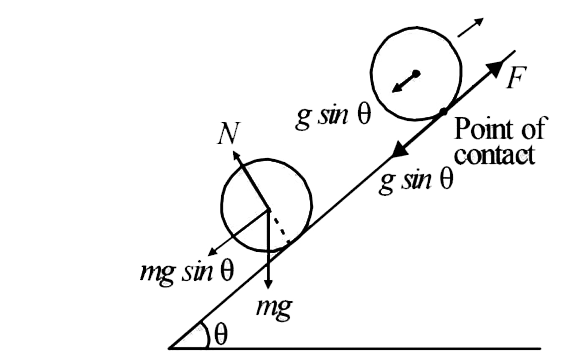A cylinder rolls up an inclined plane, reaches some height, and then rolls down (without slipping throughout these motions). The directions of the frictional force acting on the cylinder are.
up the incline while ascending and down the incline descending
up the incline while ascending as well as descending
down the incline while ascending and up the incline while descending
down the incline while ascending as well as descending.
The correct Answer is:B
(b) Imagine the cylinder to
be moving on a frictionless surface. In
both the cases the
acceleration of the
centre of mass of the cylinder is g sin θ. This
is also the acceleration
of the point of contact
of the cylinder with the inclined surface. Also no torque
(about the centre of cylinder) is acting on the cylinder
since we assumed the surface to be frictionless and
the forces acting on the cylinder is mg and N which
pass through the centre of cylinder. Therefore the net
movement of the point of contact in both the cases is in the downward directoin as shown. Therefore the frictional force will act in the upward direction in both
the cases.

Topper's Solved these Questions
- ROTATIONAL MOTIONBOOK - SUNIL BATRA (41 YEARS IITJEE PHYSICS)CHAPTER - ROTATIONAL MOTIONEXERCISE - MCQs with one correct answer
1 Videos
- MOTIONBOOK - SUNIL BATRA (41 YEARS IITJEE PHYSICS)CHAPTER - MOTIONEXERCISE - JEE Main And Advanced
63 Videos
- SIMPLE HARMONIC MOTIONBOOK - SUNIL BATRA (41 YEARS IITJEE PHYSICS)CHAPTER - SIMPLE HARMONIC MOTIONEXERCISE - JEE Main And Advanced
69 Videos
Similar Questions
A solid cylinder at rest at top of an inclined plane of height 2.7m rolls down without slipping. If the same cylinder has to slide down a frictionaly inclined plane and acquires the same velocity as that acquired by centre of mass of rolling cylinder at the bottom of the incline, what should be the height of inclined plane ?
View SolutionA solid cylinder at rest at top of an inclined plane of height 2.7 m rolls down without slipping. If the same cylinder has to slide down a frictionless inclined plane and acquires the same velocity as that acquired by centre of mass of rolling cylinder at the bottom of the incline, what should be the height of inclined plane?
View Solution
Knowledge Check
A cylinder rolls up an inclined plane, reaches someheight and then rolls down (without slipping throught these motions). The direction of the frictional force acting on the cylinder are -
AUp the incline while ascending and down the incline whilse descendingBUp the incline while ascending as well as descendingCdown the incline while ascending and up the incline while descendingDdown the incline while ascending as well as descendingA cylinder rolls down two different inclined planes of the same height but of different inclinations
AIn both cases the speed and time of descent will be differentBIn both cases the speed and time of descent will be sameCThe speed will be different but time of descent will be sameDThe time of descent will be different but speed will be sameA drum of radius R and mass M, rolls down without slipping along an inclined plane of angle θ. The frictional force-
ADecreases the rotational and translational motionBDissipates energy as heatCDecreases the rotational motionDConverts translational energy to rotational energy
A drum of radius R and mass M rolls down without slipping along an inclined plane of angle θ. The frictional force
View SolutionA drum of radius R and mass M, rolls down without slipping along an inclined plane of angle θ. The frictional force-
View SolutionA solid cylinder of mass M and radius R rolls down an inclined plane of height h without slipping. The speed of its centre when it reaches the bottom is.
View SolutionA cylinder rolls down an inclined plane of inclination 30∘, the acceleration of cylinder is
View SolutionA cylinder rolls without slipping down an inclined plane, the number of degrees of freedom it has, is
View Solution
